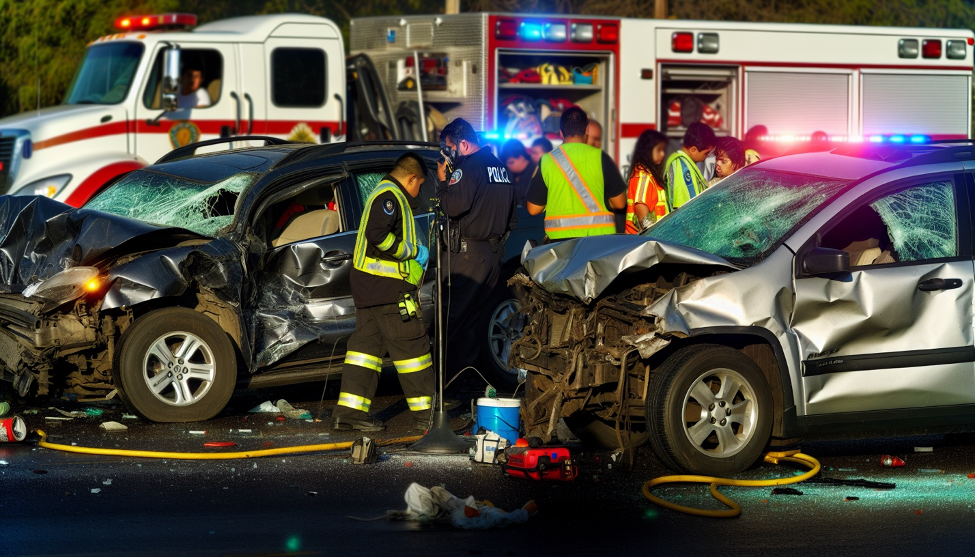Stephen Rosen • Jan 19, 2024
Dealing with unexpected emotional upheaval after a car accident could be an indicator of PTSD, an often misunderstood condition impeding daily routine and quality of life. This article dissects PTSD and addresses how it could manifest following a car crash, equipping you with knowledge about its signs and symptoms as well as offering insight into available treatment options without overwhelming medical jargon.
Key Takeaways
- PTSD following a car accident can manifest through a range of symptoms such as intrusive memories, avoidance, mood and thought changes, and alterations in physical and emotional reactions, potentially interfering with daily life for years.
- The link between motor vehicle accidents and PTSD is significant, with a pooled prevalence of 22.25% among survivors; treatment involving cognitive therapy, exposure therapy, EMDR, medication, and personal coping strategies is available and can be effective.
- Legal recourse may be available for individuals suffering from PTSD as a result of a car accident, requiring comprehensive documentation and potentially including compensation for both economic and non-economic damages.
Understanding Post-Traumatic Stress Disorder (PTSD)

Posttraumatic stress disorder (PTSD), or developing PTSD, is a mental health disorder that originates from experiencing or witnessing a traumatic event, such as:
- a serious car accident
- physical or sexual assault
- military combat
- natural disasters
Unlike the normal difficulties we face after trauma, which improve with self-care, PTSD can persist for years and significantly interfere with an individual’s daily life.
PTSD is generally diagnosed after a psychological examination using the DSM-5 criteria set forth by the American Psychiatric Association.
The Nature of PTSD
But what does PTSD look like? PTSD is characterized by persistent mental and emotional stress, often leading to severe anxiety and uncontrollable thoughts about the traumatic event. The symptoms typically fall into four categories:
- Intrusive memories
- Avoidance
- Mood and thought changes
- Changes in physical or emotional reactions
These symptoms may begin shortly after the event or emerge years later.
Intrusive memories can include recurrent unwanted memories or dreams related to the event, while avoidance symptoms involve evading reminders of the trauma. Mood and thought changes encompass negative self-perception and a lack of enjoyment in activities. The prevalence of PTSD among road traffic accident (RTA) survivors varies greatly, reflecting the complex nature of how individuals process and react to traumatic events
.
Recognizing PTSD Symptoms
The first stride towards recovery involves recognizing the symptoms of PTSD. After a car accident, individuals may experience:
- Recurrent unwanted memories of the accident
- Severe emotional distress or physical reactions to reminders of the event
- Avoidance behaviors, such as steering clear of reminders of the trauma and struggling with driving or being in a car
Changes in physical or emotional reactions can include:
- Heightened startle responses
- Hypervigilance
- Difficulty sleeping or concentrating
- Increase in anxiety and anxiety-related behaviors
These symptoms can vary in intensity, often becoming stronger during periods of stress or when encountering reminders of the traumatic event.
The Link Between Motor Vehicle Accidents and PTSD

PTSD in the general population is predominantly caused by motor vehicle accidents. The pooled prevalence of PTSD among motor vehicle accident survivors is 22.25%, with individual studies reporting rates ranging from 6.3% to a staggering 58.3%.
Interestingly, women who survive road traffic accidents have a higher prevalence of PTSD (27.61%) compared to male survivors (20.49%). It’s also worth noting that structured interviews show higher PTSD prevalence in RTA survivors than self-report questionnaires, and the time frame post-accident does not significantly affect the prevalence rates when assessed at less than 1 year versus at 1 year or more.
Identifying Signs of PTSD After a Car Accident
To identify car accident PTSD symptoms, one should observe emotional responses, physical and behavioral changes, as well as the persistence of these symptoms. This includes avoidance behaviors such as steering clear of discussing or thinking about the car accident, changing driving habits, experiencing heightened startle responses, as well as feelings of numbness or depression.
Emotional Responses to Trauma
Emotional responses to trauma can take many forms. Following a traumatic car accident, individuals may endure a range of emotions including:
- anger
- sadness
- fear
- guilt
Depression and anger post-accident can manifest as emotional numbness and may act to mask deeper psychological pain.
Victims of car accidents can suffer from emotional detachment and extreme loneliness, challenging their ability to reconnect with the joy in once pleasurable activities. The severity of PTSD symptoms can fluctuate over time, with stress or reminders of the trauma potentially exacerbating emotional reactions. Individuals with PTSD may encounter mood swings and experience irritability and anger over seemingly trivial matters.
Coping with the aftermath of a car accident may involve grieving for lost safety and the pre-trauma self, and car accident victims may struggle with self-blame and questions of self-worth.
Physical and Behavioral Changes
PTSD can also induce physical and behavioral changes. Sleep disturbances such as difficulty falling or staying asleep and having vivid or disturbing dreams about the accident are common symptoms of PTSD in car accident survivors. MVA survivors with PTSD may experience chronic pain at a high prevalence rate of 69%, impacting lifestyle and complicating treatment of PTSD.
An increased bodily startle response is a physical indicator of PTSD following a car accident, with survivors exhibiting excessive jumpiness and heightened reactions to external stimuli. In the aftermath of a car accident, individuals with PTSD may demonstrate behavioral and emotional changes, such as:
- Anxiety associated with being in a vehicle
- Social withdrawal
- Intrusive thoughts filled with disturbing content related to the accident
- Varying intensities of symptoms over time.
Seeking Professional Help: The Role of Mental Health Experts

Seeking treatment for PTSD after a car accident is crucial as it can impact:
- Health
- Relationships
- Career
- Opportunities
The essential role of mental health professionals is emphasized by the substantial impact of psychological distress on the well-being of motor vehicle collision (MVC) survivors.
The level of psychological distress, which can be a result of mental trauma, does not necessarily mirror the severity of the injury; even non-catastrophic injuries can be traumatizing and debilitating. Empirical literature emphasizes that effective psychological interventions are important for the treatment of PTSD in survivors of motor vehicle collisions.
Therapeutic Approaches to PTSD
There are various therapeutic approaches to managing PTSD. Treatment options for PTSD after a car accident include cognitive therapy, exposure therapy, EMDR (Eye Movement Desensitization and Reprocessing), and various medications. Cognitive Behavioral Therapy (CBT) is effective for MVA-related PTSD, with treatment focusing on strengthening coping skills, re-interpretation of dysfunctional cognitions, and addressing changes in physical functioning.
Controlled trials show that short, individual-format CBT treatments can significantly reduce symptoms of MVA-related PTSD and that many patients no longer meet PTSD criteria after CBT. Prolonged Exposure Therapy (PE), a type of cognitive behavioral therapy, encourages patients to relive the trauma in a controlled environment, which can be particularly helpful for overcoming fears associated with driving after an accident.
EMDR targets the neural network altered by PTSD, treating conditioned fear responses that result from the traumatic event and helping normalize dysfunctional networks.
Medications and PTSD Management
For some, medication might prove pivotal in managing the symptoms of PTSD. Anti-anxiety or antidepressant drugs may be recommended for coping with the emotional ramifications of a car accident. These medications can:
- Provide stability
- Improve sleep
- Decrease symptoms of depression and anxiety
- Aid in coping with reminders of the traumatic event
Strategies for Coping with PTSD After a Car Accident

The management of PTSD entails a blend of professional intervention and personal coping strategies. Cultivating patience toward oneself is crucial after experiencing a car accident, as this can help refocus energies on healing and recovery, especially when dealing with PTSD symptoms.
Staying physically active is one way for survivors of car accidents to rebuild their sense of control and confidence, contributing to their overall recovery from trauma.
Self-Help Techniques for Managing Symptoms
There are several self-help techniques that can help manage PTSD symptoms. Some of these techniques include:
- Practicing mindfulness or meditation to remain grounded in the present moment and leave past trauma behind
- Using breathing exercises to reduce anxiety and promote relaxation
- Engaging in regular physical exercise to release tension and improve mood
- Seeking support from friends, family, or support groups to share experiences and receive validation
- Trying relaxation techniques such as progressive muscle relaxation or guided imagery to calm the mind and body
These techniques can be helpful for individuals with PTSD, including those who have experienced trauma from motor vehicle accidents.
During therapy sessions, mindfulness meditation is valuable in helping individuals with MVA-related PTSD increase their focus. Mindfulness meditation assists in re-directing one’s thoughts away from past or future concerns and towards being fully engaged in the present.
Building a Support Network
Building a robust support network is a key component of recovery from PTSD. Social support from friends and family is a key component of the PTSD recovery process, offering emotional validation and diverse perspectives on handling emotional struggles. Both subjective support and the utilization of available support are important dimensions of social support in recovery from PTSD, emphasizing the need to feel supported and to actively use the support network.
Organizations such as the Anxiety and Depression Association of America provide valuable resources, including educational materials and webinars, for individuals dealing with the emotional aftermath of car accidents. Group therapy sessions provide a safe space for individuals with PTSD to discuss their experiences without the worry of causing trauma to friends and loved ones, which can be a major step towards recovery.
Legal Considerations: Compensation for PTSD

In addition to the emotional and physical toll, car accidents can also lead to significant financial burdens. Compensation may be available for individuals suffering from PTSD caused by a car accident.
Individuals with PTSD due to another person’s negligence may be entitled to financial compensation.
Documenting PTSD for Legal Claims
Comprehensive documentation is vital while seeking compensation for PTSD. Documenting PTSD for a legal claim requires comprehensive evidence illustrating both the condition’s existence and its impact on the individual’s life. An official diagnosis of PTSD by a qualified medical professional, along with clinical notes, is key evidence in proving psychological trauma after a car accident.
The PTSD claim can be supported by:
- Witness statements
- Photos and videos from the accident scene
- The police report including fault determination
- Documentation of medical treatment and therapy costs
To navigate the legal aspects effectively and ensure the claim is presented appropriately, the counsel of an experienced personal injury lawyer is indispensable.
Navigating the Claims Process
The claims process can be complex and daunting, but understanding how it works can help. Claims for PTSD can be pursued even if the claimant did not sustain physical injuries in the accident, provided there is a mental health professional’s diagnosis linking the PTSD directly to the accident. PTSD compensation claims may encompass special damages for quantifiable costs such as medical bills and lost wages, along with general damages which consider emotional distress, pain and suffering, and reduced quality of life.
The calculation for noneconomic damages may employ a multiplier method, taking the economic damages’ total and multiplying it by a number to reflect the severity of PTSD. Working with a personal injury attorney, preferably one with experience in psychological trauma, is advised for effectively navigating legal processes, as they may offer free consultations and work on a contingency fee basis. Expert testimony is essential in establishing the PTSD diagnosis, its link to the car accident, and in projecting the condition’s future financial impact for the claim.
Reclaiming Control: Returning to Everyday Life
A multifaceted approach is needed to reclaim control after a car accident. Here are some steps to consider:
- Gradually return to driving, starting with short trips and gradually increasing the distance.
- Engage in enjoyable activities to help reduce stress and anxiety related to the accident.
- Practice self-care, such as getting enough sleep, eating well, and exercising regularly.
- Consider taking defensive driving courses to equip yourself with skills to handle various road situations confidently.
By following these steps, you can take control of your life after a car accident.
Cultivating good driving behaviors and focusing on controllable aspects of driving can significantly help those coping with PTSD after a car accident.
Gradual Exposure to Driving
Getting back behind the wheel after a car accident can be a daunting task. Here are some strategies to help overcome the avoidance of driving post-PTSD:
- Enroll in driving classes to build confidence and improve driving skills.
- Engage in trauma-related activities, such as driving or being a passenger, to gradually expose yourself to driving situations.
- Temporarily utilize alternative forms of transportation, such as public transportation or carpooling, to lessen the pressure of driving and allow yourself time to cope with your PTSD in a controlled manner.
By implementing these strategies, you can gradually regain your confidence and overcome the fear of driving.
Friend, family, and mental health professional support is crucial for individuals with PTSD to gradually work their way up to driving again, thereby reducing their driving avoidance. Implementing safe driving tips such as:
- leaving extra space between cars
- wearing seat belts
- obeying traffic signals
- minimizing distractions
can help prevent future accidents and contribute to regaining driving confidence.
Pursuing Enjoyable Activities
Recovery from PTSD also involves reclaiming the joy in everyday life. Staying social and engaging in enjoyable activities can help rebuild a sense of normalcy and contribute to the healing process after a traumatic car accident. Accepting the fear of riding as a passenger and finding ways to distract oneself, such as through reading or listening to podcasts, can help manage anxiety.
Taking a test drive with another driver can reduce nervousness by providing a sense of safety and allowing for open communication about fears. Joining a support group for vehophobia can provide a sense of community and understanding, which can be supportive as individuals work to overcome their anxiety and reclaim their enjoyment of everyday activities.
Summary
In conclusion, PTSD is a serious but treatable condition that can arise from traumatic events such as car accidents. Through understanding and recognizing the symptoms, seeking professional help, employing self-help techniques, and leveraging legal avenues for compensation, individuals can effectively manage PTSD and reclaim their lives. Remember, every journey begins with a single step, and the journey to recovery from PTSD is no different.
Frequently Asked Questions
What are the 5 symptoms of PTSD?
- The 5 symptoms of PTSD include reliving aspects of what happened and cognitive and mood symptoms. These can manifest as flashbacks, nightmares, negative thoughts, and feeling detached from others.
How does PTSD affect someone?
- PTSD can affect a person’s ability to work, perform day-to-day activities, and relate to their family and friends. Individuals may seem uninterested or distant as they try to block out painful memories.
What is PTSD and how is it diagnosed?
- PTSD is a mental health disorder caused by traumatic events. It is diagnosed through a psychological exam using the DSM-5 criteria.
What are some common symptoms of PTSD after a car accident?
- Some common symptoms of PTSD after a car accident include recurrent unwanted memories, severe emotional distress, and avoidance behaviors such as avoiding reminders of the trauma. It’s important to seek professional help if you experience these symptoms.
What therapeutic approaches are used to treat PTSD?
- Therapeutic approaches for treating PTSD include Cognitive Behavioral Therapy (CBT), Prolonged Exposure Therapy (PE), and Eye Movement Desensitization and Reprocessing (EMDR). These therapies have shown effectiveness in managing symptoms of PTSD.

